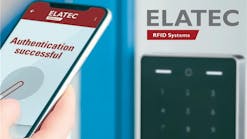Man-Made Problem
At a jobsite, the locksmith was called because there were problems with a door. Going to the door, he noticed the butt hinge had a major problem. It appeared that someone went at the butt hinge in an attempt to improve the door closing and lost.
Noke Padlock Opens Via Smartphone
FUZdesigns will be introducing the Noke (pronounced Noh-key) Bluetooth Padlock designed to open using a smartphone without removing the phone from your pocket. This solid steel padlock is similar to the round body American A700 Series having a 8mm hardened boron shackle. The battery powered Nokey is completely round and there is no lock cylinder. The side battery cover can be removed only when unlocked.
The Noke access code can be shared with multiple iOS, Android and Windows smartphones or other devices. Unlocking permissions can be permanent, one-time, or custom in different options including geographic. Noke allows the user to create a custom access (emergency) code to unlock the padlock in case the phone is dead or unavailable. In order to enter the access code, the user presses down the shackle in either long or short holds. The LED indicates each entry.
For more information, visit http://fuzdesigns.com.
SDC EntryCheck 923 Series Keypads
SDC has introduced the standalone EntryCheck 923 Series Digital Keypad designed to control access of a single entry having up to 500 users. The EntryCheck 923 keypad operates on 12/24 VAC/DC. The keypad accommodates four- to six-digit codes. The 923P keypad adds a proximity reader to the keypad. These keypads are equipped with four outputs ‑ two relays and two solid state outputs.
The weather resistant, cast vandal resistant housing has cast metal blue backlit buttons 1-10, "*" and "#". The tactile buttons have selectable volume. For more information, contact your local locksmith distributor or SDC at Web Site: www.sdcsecurity.com.
Boon Edam Tailgating Survey
Boon Edam Inc. conducted an internal survey of 3,000 contacts from their database in late 2014 in regards to issues surrounding tailgating entry into buildings. Tailgating (piggybacking) is when a person closely follows an authorized person in order to gain entry into a restricted area. The goal of the follower is to gain entry without having to show authorization. The follower may or may not know the authorized person. Tailgating often has the connotation of being an unauthorized or illegal act.
The survey asked end users, security consultants and integrators to share their perceptions about the risk of tailgating into their facilities. The survey consisted of eight multiple choice questions with comments available for certain questions. The survey achieved a response rate of approximately 8%, and respondents were primarily from North America.
Based on the findings of the respondents; "Over 70% of respondents believe they are currently vulnerable to a security breach from tailgating. More than 50% of those surveyed believe the cost of a breach caused by tailgating would be from $150,000 up to “too high to measure.”
Over 70% of respondents believe a barrier of some type is the most effective way to curtail tailgating, and over 60% reported they use a physical security barrier of some type as well as employee education.
Only 15% said they are currently tracking tailgating incidents regularly.
The majority of survey respondents appear to take tailgating and its risks very seriously and are deploying a variety of strategies to combat it, but they still consider themselves vulnerable. Based on media coverage over the past 10 years, a majority of respondents believe security breaches from tailgating have remained constant or are on the rise.
The results of this survey confirm for Boon Edam that there will be investment in tailgating prevention, and/or increasing the overall level of physical security.
To see the survey, go to Web Site: www.boonedam.us/survey-results-reveal-high-perceived-risks-tailgating
Royal Boon Edam, the parent company, is a market leader in entry solutions in managing the movement of people into and through many types of edifices.
More Tailgating Information
Tailgating is a very common breach of security. There are innocent tailgating instances, where an employee opening a door offers courtesy to persons coming behind by keeping the door open for them. There are also instances where someone unknown gets in close proximity to an employee and follows them in. The employee may not feel comfortable stopping that person for a number of reasons including fear for their safety.
Tailgating has the potential for a criminal act. Someone unknown is in the building. Even if the perimeter is not locked to the public, many buildings, have restricted areas. Examples are hospital operating rooms and laboratories.
Restricting tailgating involves multiple considerations. The least expensive is to train employees to make sure doors close immediately behind them.
Most methods of restricting will dramatically slow the access and egress through the opening.
The slowest method would be a mantrap, as only one person should go through the two sets of doors at a time.
A little faster would be to use a turnstile that admits only one person through per swipe of a badge reader. There are many different types of turnstiles including the traditional wheel, sliding paddles, Plexiglas barriers, etc. These methods still require a type of identification to be able to restrict the unauthorized.
Even with proximity or SmartCards, if there is sufficient room for more than one person, tailgating will probably occur.
The alternative is to have a security guard monitor the movement of employees. This is expensive and not 100 percent guaranteed.
Other methods can be cameras and/or sensors that determine if more than one person enters.
The better solutions will occur when computer processors become fast enough to identify people when they are at the perimeter of the property, away from the building's entrance. As the person comes closer to the entry, the person’s credential, possibly a cell phone, will provide the second round of authorization. The final confirmation will be biometrics. This three-part credential will not solve all of the problems but it will limit the uninitiated.
However, today to maximize security, make sure the door closers are in adjustment and closing at the required speeds. Make sure the locks, exit devices and latches are properly operating, so they secure the door every time. Make sure the hinges are securely mounted and lubricated with no dragging. If the door closes slowly or requires additional closing force, consider using a continuous hinge.
Kwikset Adds SmartKey Padlock
Kwikset has introduced the SmartKey Padlock, a steel laminated padlock with top to bottom bumpers equipped with the SmartKey Lock Cylinder. For protection, the padlock is equipped with a hardened molybdenum shackle. The SmartKey Padlock is available with two shackle sizes; standard and long. The long shackle has a two inch clearance.
For more information, contact your local locksmith distributor or Kwikset at Web Site: www.kwikset.com.
Car-Opening Techniques: 2006-15 Hyundai Accent
This month we will offer car-opening tool manufacturer's recommended techniques for opening the 2006-15 Hyundai Accent. The Accent is equipped with bicycle style cables inside the door cavity.
FYI: Some Hyundai Accent models are designed to permit only the driver’s side inside door handle to override the lock mechanism. This design allows the door to be opened without first moving the inside lock control rocker to the unlocked position.
Caution: When using a car-opening tool whose tip contacts the inside door controls, tape the end to prevent marring.
It is always a good idea to using some diluted dish soap to prevent damage to the weather stripping when inserting wedges or tools. Failure to remove the wedges prior to raising the car-opening tool into the passenger compartment may result in the window glass breaking.
The following opening methods can be used to unlock the 2006-15 Hyundai Accent:
Use the High Tech Tools Small Inside Access Tool 65 to unlock the front passenger door locking mechanism. Insert a wedge between the glass and the weather stripping directly above the inside door locking button. Insert the 65 car-opening tool into the door cavity just rearward of the wedge with the tip facing forward. Raise the wedge to release pressure on the window glass. Lower the tool until the curved tip is a few inches beneath the bottom of the window glass. Rotate counterclockwise slightly until the arc is on the passenger compartment side of the window glass. Slowly raise the 65 Tool until the arc and tip are in the passenger compartment. Manipulate the tool's tip until it contacts the door lock button. Move the tool to unlock the door locking mechanism. Pull up on the outside door handle to open the door.
Use the Pro-Lok AO-34 “MCOT-Narrow Tool” and an inflatable wedge to unlock the front passenger door locking mechanism. Begin by inserting the inflatable wedge 13 inches from the front edge of the window glass of the front passenger door. Inflate the wedge. Carefully insert the A-34 11 inches from the front edge of the window glass with the tip facing forward. Carefully lower the tool 15 inches into the door cavity. Deflate the wedge. Rotate the tool a few degrees counterclockwise until the upper bend is on the passenger compartment side of the glass. Slowly raise the car-opening tool until the tip is in the passenger compartment. Rotate the tool 90 degrees counterclockwise so the tip is against the inside manual l-unlock button. Rotate the button rearward to unlock the locking mechanism. Pull up on the outside door handle to open the door.
Use the Slide Lock AutoBuster III car-opening tool and two wedges to unlock the rear passenger door locking mechanism. Insert the two wedges wide enough apart at the front of the rear passenger door to permit the car-opening tool slide between. Insert the AutoBuster III between the wedges wit the tip facing rearward. Slide the tool into the door cavity until it is completely within the door cavity. Remove both wedges to relieve pressure at the interior side of glass. Rotate the tool slightly clockwise so the loop enters on the passenger compartment side of the glass. Lift the tool into the passenger compartment. Carefully manipulate the car-opening tool until the tip contacts the lock rocker. Move the rocker to the unlocked position to unlock the door locking mechanism.
Use the Tech-Train Productions TT-1015 car-opening tool and two wedges to unlock the front passenger door locking mechanism. Insert the two wedges approximately eight inches apart near the inside door handle assembly. Carefully insert the TT-1015 tool into the door cavity with the upper bend facing forward. Carefully lower the tool until the upper bend is beneath the glass. Rotate the tool a few degrees counterclockwise until the upper bend is on the passenger compartment side of the glass. Slowly raise the car-opening tool until the upper bend raises the weather stripping on the passenger compartment side of the glass. Stop immediately and remove the two wedges. Raise the tool until the tip is visible. Manipulate the TT-1015 so the tip is against the inside lock control rocker. Use the tip to flip the rocker to the unlocked position. With the locking mechanism unlocked, pull up on the outside door handle to open the door.
Always follow the manufacturers’ instructions to remove the various car-opening tools. The direction to rotate the door lock plug to the unlocked position is clockwise.
For more information, contact your local locksmith distributor or following car-opening tool manufacturers:
Access Tools (High Tech): Telephone 800-323-8324 Website: www. AccessToolsUSA.com
Pro-Lok: Telephone: 714-633-0681. Web site: www.pro-lok.com
Slide Lock Tool Co. Inc.: Telephone: 800-336-8812 . Website: www.z-tool.com
Steck Manufacturing: Telephone: 800-227-8325. Web site: www.steckmfg.com
Lockmasters Inc. (Tech-Train): Telephone: 800-654-0637 Website: www.lockmasters.com
We are interested in printing opening methods from other car-opening tool manufacturers. Contact Jerry Levine, Telephone: 818-700-0640. E-mail: [email protected].






